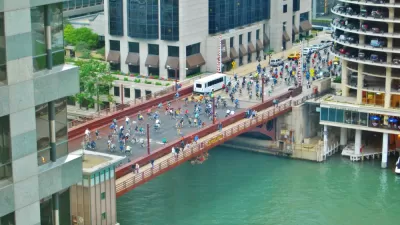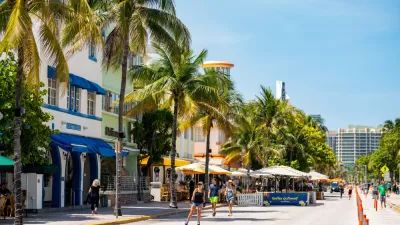As local councils debate making permanent changes implemented last year, can pedestrian and cycling advocates hold on to their victories?

Since the start of the pandemic, writes Niamh McIntyre for The Guardian, England's roads have been the testing grounds for a "grand experiment" that has led to a bitter standoff between pedestrian advocates and motorists. As part of mayor Sadiq Khan's Streetspace plan, implemented last year as an "urgent and swift response" to the pandemic and London's broader need to reduce congestion and pollution, "funnelled money from the government’s new active-travel fund to London’s boroughs for low-traffic neighbourhoods (LTNs) and other projects to encourage walking and cycling, such as temporary cycle lanes and timed road closures outside schools."
Since almost half of London car trips are under two miles, "the theory is that by reducing the amount of road space for cars, people will find other ways to make short journeys." Opponents argue that not everyone can easily take alternate routes, and that the measures only increase traffic and congestion on other streets—an assertion not borne out by evidence: "early monitoring of new LTNs in Hackney and Lambeth found that traffic on main roads hardly increased at all," and "data from established LTNs in Walthamstow showed the opposite."
While early "enthusiasm for LTNs brought about a rare consensus between the Conservative government and the Labour mayor of London, as well as Greens and pro-cycling groups," the backlash as traffic returns to London streets has been severe. In addition to DIY removal of LTN infrastructure, "opponents of the mayor’s walking and cycling plans have pursued numerous legal challenges to the new policies."
The future of LTN and other programs started during the pandemic will hinge on the next few months "as councils push for temporary schemes to become permanent, and objectors fight for the right to drive wherever they need to go."
FULL STORY: Traffic wars: who will win the battle for city streets?

Alabama: Trump Terminates Settlements for Black Communities Harmed By Raw Sewage
Trump deemed the landmark civil rights agreement “illegal DEI and environmental justice policy.”

Planetizen Federal Action Tracker
A weekly monitor of how Trump’s orders and actions are impacting planners and planning in America.

The 120 Year Old Tiny Home Villages That Sheltered San Francisco’s Earthquake Refugees
More than a century ago, San Francisco mobilized to house thousands of residents displaced by the 1906 earthquake. Could their strategy offer a model for the present?

Rural Missouri Transit Service Could Lose State Funding
OATS Transit offers low-cost rides to primarily elderly rural residents with little or no access to other transportation options.

Opinion: California’s SB 79 Would Improve Housing Affordability and Transit Access
A proposed bill would legalize transit-oriented development statewide.

Record Temperatures Prompt Push for Environmental Justice Bills
Nevada legislators are proposing laws that would mandate heat mitigation measures to protect residents from the impacts of extreme heat.
Urban Design for Planners 1: Software Tools
This six-course series explores essential urban design concepts using open source software and equips planners with the tools they need to participate fully in the urban design process.
Planning for Universal Design
Learn the tools for implementing Universal Design in planning regulations.
Clanton & Associates, Inc.
Jessamine County Fiscal Court
Institute for Housing and Urban Development Studies (IHS)
City of Grandview
Harvard GSD Executive Education
Toledo-Lucas County Plan Commissions
Salt Lake City
NYU Wagner Graduate School of Public Service





























